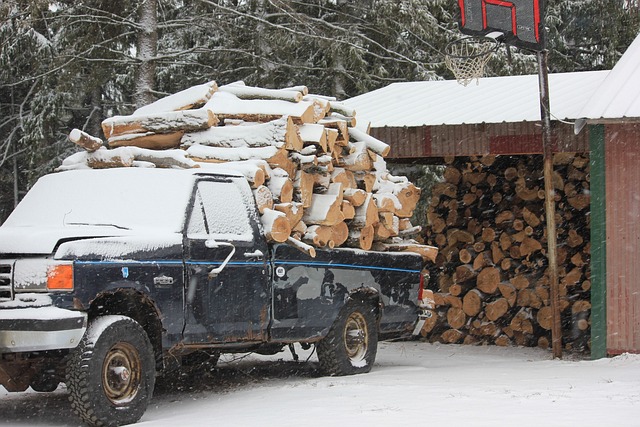Have you ever wondered if storing firewood in your garage is a smart move? As someone who values a cozy fireplace and a warm home during those chilly winter nights, I understand the importance of finding the perfect storage solution for your firewood. But should you store firewood in your garage?
Whether or not you should store firewood in your garage depends on various factors and considerations. While storing firewood in your garage offers benefits like easy accessibility and protection from the elements, there are also potential drawbacks to be mindful of, such as space constraints, indoor air quality concerns, and fire hazards.
In this comprehensive guide, I’m going to explore if you should store firewood in your garage in detail. By the end of this guide, you’ll have all the information you need to make a well-informed decision. Let’s dive in!
Benefits of Storing Firewood in Your Garage
Let’s take a closer look at the fantastic benefits of storing firewood in your garage:
- Easy Accessibility: Picture this: it’s a frosty winter evening, and you’re curled up on the couch, craving the comforting warmth of a crackling fire. Instead of braving the elements and trudging through the cold or rain, imagine having your stash of firewood just a few steps away in your garage. Storing firewood in your garage grants you easy access, making those cozy nights by the fire even more enjoyable.
- Protection from the Elements: Rain, snow, and excess moisture can wreak havoc on firewood, making it difficult to ignite and causing it to burn less efficiently. But fear not! By storing your firewood in the cozy confines of your garage, you shield it from the harsh elements. Your wood will stay dry, ready to burn, and perfect for creating that warm, inviting ambiance in your home.
- Pest Prevention: Pests have a knack for finding cozy homes, and your firewood pile can be quite tempting to critters like termites, ants, and rodents. Storing firewood inside your garage acts as a deterrent to these unwanted guests. The solid walls of your garage provide an extra layer of protection, minimizing the risk of infestations and ensuring that your woodpile remains pest-free.
By storing your firewood in your garage, you’re not only ensuring easy access to warmth but also protecting your wood from the elements and keeping those pesky pests at bay.
Drawbacks to Consider
While storing firewood in your garage offers many benefits, it’s important to consider the potential drawbacks as well. Let’s explore them together:
- Space Constraints: Your garage is a valuable space that serves multiple purposes, such as parking your car or storing other belongings. Storing firewood in your garage may occupy precious space, limiting your ability to use it for other purposes. Before deciding to store firewood in your garage, assess your available space and consider if the trade-off is worth it for your specific needs.
- Indoor Air Quality: Firewood releases moisture and can emit small amounts of smoke, which may affect the air quality within your garage. Proper ventilation becomes crucial to maintain good air circulation and prevent any potential buildup of smoke or mold. If you have concerns about indoor air quality or poor ventilation in your garage, storing firewood indoors may not be the best option for you.
- Fire Hazards: While firewood itself is not highly flammable, storing it in close proximity to heat sources, electrical equipment, or flammable materials can increase the risk of fire. It’s important to exercise caution and ensure that your firewood is stored away from potential ignition sources to minimize any fire hazards.
Evaluate your available space, ventilation, and potential fire hazards to determine if alternative storage options might be more suitable for your needs. Safety and practicality should always be a top priority!
How Do You Store Firewood in Your Garage?
To store firewood in your garage properly, follow these 8 steps:
- Choose a Suitable Location: Select an area in your garage that is well-ventilated, away from potential fire hazards, and provides sufficient space for the woodpile. Consider keeping it near an entrance for easy access.
- Elevate the Firewood: Place the firewood on pallets, raised platforms, or racks to keep it off the ground. This prevents moisture absorption and helps deter pests from nesting in the woodpile.
- Create Proper Airflow: Ensure there is adequate air circulation around the firewood. Leave space between the woodpile and walls or other stored items to allow air to flow freely and aid in the drying process.
- Stack the Firewood: Stack the firewood in a stable and organized manner. Start with a solid base layer, stacking the logs evenly. Alternate the direction of the logs in each layer to create stability and prevent the stack from leaning or collapsing.
- Leave a Gap for Ventilation: Place small pieces of wood or spacers between each row of logs to allow air to circulate and promote drying. This gap also helps prevent moisture buildup and encourages the wood to dry evenly.
- Monitor Moisture Levels: Check the moisture content of the firewood periodically using a moisture meter. Ideally, the moisture content should be below 20% for efficient burning. If the wood is too moist, consider providing additional ventilation or using a dehumidifier in the garage.
- Maintain Fire Safety: Keep the firewood away from any potential ignition sources, such as electrical outlets, appliances, or open flames. Ensure there is a safe distance between the woodpile and any heat sources, reducing the risk of fire.
- Regularly Inspect and Rotate: Check the firewood regularly for signs of decay, mold, or insect infestation. Rotate the woodpile by using older logs first to ensure that the wood is used before it becomes less suitable for burning.
Properly stored firewood will remain dry, accessible, and ready to provide cozy warmth during those chilly nights.
Alternative Storage Options
If the drawbacks of storing firewood in your garage have given you pause, fear not! There are alternative storage options that you can explore. Let’s take a look.
- Outdoor Firewood Sheds: If you have space in your backyard, building or purchasing a dedicated firewood shed can be a fantastic solution. These sheds are designed to protect your firewood from the elements while keeping it easily accessible. With a firewood shed, you can free up valuable space in your garage and have a dedicated storage area for your woodpile.
- Covered Firewood Racks: Another outdoor storage option is a covered firewood rack. These racks typically feature a sturdy structure with a waterproof cover, providing protection against rain and snow while allowing for proper air circulation. Covered firewood racks are a great compromise between storing wood indoors and keeping it outside, as they keep your firewood dry and accessible without occupying space in your garage.
- Seasoned Firewood Suppliers: If you’re limited on storage space or prefer not to store firewood yourself, consider sourcing seasoned firewood from reputable suppliers. These suppliers typically offer properly seasoned firewood that is ready to burn. You can arrange for periodic deliveries or purchases as needed, eliminating the need for storing large quantities of firewood on your property.
Whether it’s a dedicated firewood shed, a covered rack, or relying on seasoned firewood suppliers, there are choices available that can meet your needs while addressing the concerns you may have about storing firewood in your garage.
Conclusion
So, should you store firewood in your garage? After weighing the benefits, drawbacks, and alternative storage options, the answer ultimately depends on your specific circumstances and priorities.
Storing firewood in your garage offers the advantages of easy accessibility, protection from the elements, and pest prevention. It’s a convenient option that ensures your firewood stays dry and ready to burn. However, it’s important to consider the space constraints, potential impact on indoor air quality, and fire hazards associated with storing firewood indoors.
If your garage has ample space, proper ventilation, and you can ensure fire safety measures, storing firewood in your garage can be a viable option. However, if space is limited, you have concerns about air quality or prefer to keep firewood away from your garage, alternative storage options like outdoor firewood sheds, covered racks, or relying on seasoned firewood suppliers may be better suited to your needs.
Ultimately, prioritize safety, practicality, and your specific requirements when making the decision. With the knowledge gained from this article, you can confidently choose the storage option that aligns with your circumstances. Whether it’s in your garage, an outdoor shed, or sourced from a reputable supplier, make sure you have dry and ready-to-use firewood to keep you warm during those chilly nights.
Remember, the most important thing is to enjoy the cozy warmth of your fireplace or wood-burning stove while keeping your home safe and comfortable.
Here’s a related article: Does Firewood Need To Be Covered? Exploring The Benefits And Best Practices





